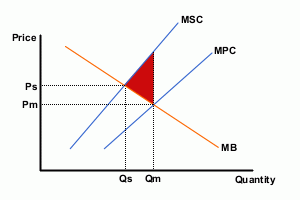By definition, externalities are defined as the “cost or benefit that affects a party who did not choose to incur that cost or benefit“.
There are 3 main types of externalities that students are expected to know in detail:
- External costs of production (e.g. manufacturing pollution, smell from farms)
- External costs of consumption a.k.a demerit goods (e.g. smoking, driving a car)
- External benefits of consumption a.k.a merit goods (e.g. education, healthcare)
The common theme to all externalities is that the transactions positively or negatively affect third parties who are not directly involved in the transaction.
It is these costs/benefits that lead to the under or over-consumption of goods and services in the economy, causing allocative inefficiencies and the associated deadweight loss.
Solving externalities.
Because externalities lead to misallocation of resources, preventing the economy from producing societal optimum quantities of the goods and services, it is obvious to students that some intervention from the government would be required to correct this market failure.
The measures taught in the “A” level syllabus usually includes the familiar means of interventions, such as the Pigovian Tax, subsidies. These measures are considered to be “straightforward” as they can be derived from the demand/supply diagrams.
Another “straightforward” tactic well-known to students would be the use of direct interventions to the market, using laws and legislations (e.g. quota, punishments or rationing).
Many JCs go one step further to teach more “fancy” measures, such as the implementation of the Tradable Permit system, which is usually utilised for External Costs of Production.
These solutions (and other similar ones) are usually enough to secure a decent grade for students’ “A” level Economics.
However, examinations are a time for students to show the examiners that they have a very good grasp of the Economic concepts, and it is only through differentiation from the crowd, that an “A” grade can be secured.
Solving externalities…elegantly.
We look again at our previous statement:
The common theme to all externalities is that the transactions positively or negatively affect third parties who are not directly involved in the transaction.
Consider Scenario A:
- Your neighbour is walking the dog on a nice sunny morning.
- As the dog walked into the distance, it decided then to take a dump roughly 100m away from your house, on the pavement.
- You are not leaving the house today, so you just needed to draw the shades, and make your morning coffee as per normal, pretending that it didn’t happen.
- Because the offending material is some distance from other houses, everybody does the same and ignores it as it starts to fester and smell really bad.
- It was some 3 hours before the Town Council cleaners arrive and clear the mess, before all of you heave a sigh of relief.
Consider Scenario B:
- Your neighbour is walking the dog on a nice sunny morning.
- As the dog walked into the distance, it decided then to take a dump right outside your doorstep.
- You were very unhappy and gave a piece of your mind to your neighbour.
- Your neighbour clears the mess and both of you consider the matter closed.
The key reason behind the vastly different outcome, has to do with where the unfortunate matter took place (outside your home, versus far from your home).
The salient fundamental reason why the negative externality was much larger in the case of Scenario A, than in Scenario B, has to do with the concept of ownership.
In Scenario A, nobody claims ownership to the pavement. It is instead left to a public institution to maintain the property.
In Scenario B, because the negative incident happened on what you considered to be your space, you decided to intervene on the matter, ensuring that you would not be made to bear the consequence of your neighbour’s (dog’s) actions.
Scenario B is clearly superior to Scenario A in terms of outcome. As a general rule, relying on public institutions for the provision of goods and services is generally considered to be inferior to market provisions because the “Invisible Hand” responds much faster and more accurately most of the time.
Enter the Coase Theorem.
Since public ownership of properties that are not privately owned leads to sub-optimal outcomes, as shown in Scenario A, can a solution as in like Scenario B be achieved through extensions of private ownership?
It is in similar context that Ronald Coase, a well-known Economist, put forth the Coase Theorem as a theory to the problem of externalities, and how it can be resolved by market forces with the right conditions.
Thankfully, “A” level students need not know the Coase Theorem in great detail – it can be fairly complicated to understand and this site does a good job in summarising its essence for you.
So how do we write about the Coase Theorem in exams? Here’s my suggested answer for students:
“The Coase Theorem can be utilised to solve the problem of externalities, by utilising property rights to internalise the costs and benefits associated with the externalities. Socially optimal outputs will be achieved because parties who own the affected properties will negotiate with the perpetuator for socially acceptable levels of output.”
And that’s actually all that needs to written. Isn’t this a very elegant solution to write about during exams, and yet still a fresh breath for your answers in the exam?
I hope that you have enjoyed reading this article of mine. I am giving my time to sharing my knowledge and every bit of support means a lot to me! Do drop me a comment or share this article on social media with your friends.
For more information about my services as a JC Economics tutor, do visit my website here.



